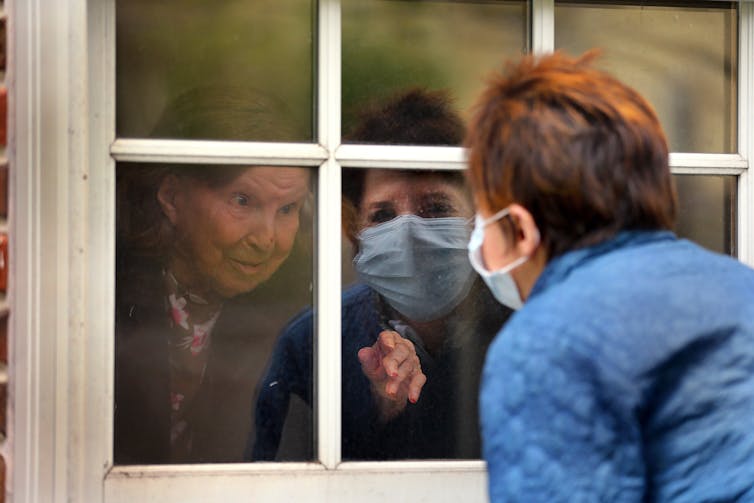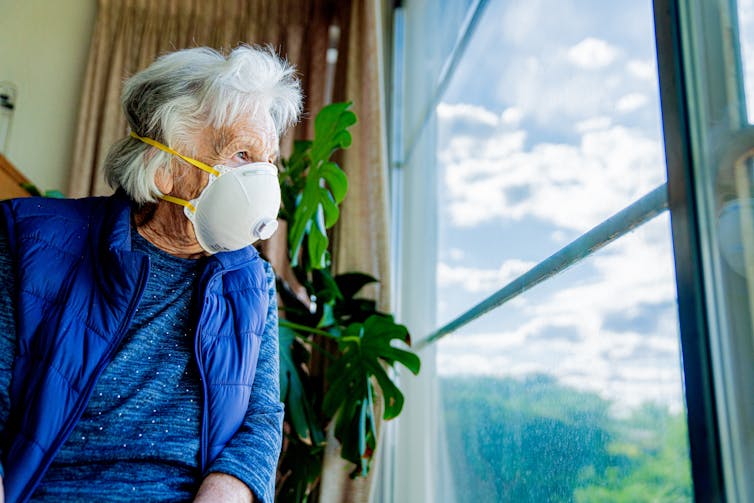How one community improved COVID-19 nursing home care with collaboration and communication
- Written by Laurie Archbald-Pannone, Associate Professor Medicine, Geriatrics, University of Virginia
Nursing home residents worldwide are particularly vulnerable[1] to the ravages of COVID-19. In the U.S. as of Aug. 2, 2020, nearly 46,000 nursing home residents[2] had died from the virus. In addition, deaths linked to nursing homes have been estimated to account for 40% of all COVID-19 deaths[3] in the U.S.
In my home state of Virginia, nursing home residents make up more than half the state’s COVID-19 related deaths[4]. That statistic alone emphasizes the critical need for infection control and sufficient support for these residencies.
I’m a physician[5] who specializes in geriatric medicine and works at an academic medical center. Since March 2020, I have led a team to develop a collaborative care model[6] for nursing homes in our community. That means bringing together hospitals, physician groups, community agencies and health departments to figure out how we can all work collectively to improve outcomes for these residents during the pandemic.
Our team’s name is GERI-PaL[7]. Its members, with their diverse backgrounds – doctors, nurses, emergency responders and public health experts – have created new ways for academic medical centers and hospitals to work with local nursing homes. We believe our model will help these facilities, not only during the pandemic, but beyond.
Among other things, our team is assisting them with infection prevention measures. This includes the coordination of testing and treatment for COVID-19. We have improved their access to sub-specialty care with telemedicine, a great tool for patients. And we help the homes obtain personal protective equipment.
Our team members have specific roles: The nurse innovator connects directly with the homes to see how we can help. A nurse practitioner, through telementoring, leads an education program for facility administrators and clinical teams. A critical care doctor sees patients with telemedicine, and geriatric doctors provide consultation and assist with palliative care (pain or other symptom relief).
 Ellen Taylor talks to her mother, Eva Taylor, age 100, through the first-floor window of a Boston nursing home facility. Because of COVID-19, family members and friends are not allowed inside. Getty Images/Boston Globe/John Tlumacki[8]
Ellen Taylor talks to her mother, Eva Taylor, age 100, through the first-floor window of a Boston nursing home facility. Because of COVID-19, family members and friends are not allowed inside. Getty Images/Boston Globe/John Tlumacki[8]
Staffing shortages at nursing homes
Prior to our regional pandemic surge, GERI-PaL had already found success[9] in building collaborations with nursing homes. But our biggest impact is happening now, as we respond to multiple facilities severely hit by COVID-19 outbreaks.
Our first and foremost concern, of course, is the care and well-being of residents. Early in the pandemic, staffing crises[10] emerged at many of the facilities. Some workers became ill, some required quarantine, and some decide not to return.
With a limited staff, coordination of care becomes more critical than ever. The remaining employees must take on new roles to make up for the loss. So we worked with the homes and primary care providers to make sure all patients were seen during remote daily rounds. In hospitals, daily rounds are typical, but it’s not standard in facilities where residents typically aren’t as sick.
We helped arrange telemedicine visits with a critical care doctor who used a virtual stethoscope to listen to heart and lung sounds remotely and connect in real-time video chat with a resident, nurse and primary care physician. This kind of care, we discovered, is effective, efficient and much easier on the resident; instead of a trip to the hospital or doctor’s office, patients can receive treatment and talk to a physician from the nursing home.
 For the elderly, loneliness is an issue, particularly during the pandemic. Getty Images/Jeremy Poland[11]
For the elderly, loneliness is an issue, particularly during the pandemic. Getty Images/Jeremy Poland[11]
Innovation is more than technology
We had local medical students call residents to talk and offer reassurance, especially during the policy changes that occurred during the initial lockdown. For the residents, this decreased their loneliness and social isolation; for the students, it was a lesson in empathy.
[The Conversation’s most important coronavirus headlines, weekly in a new science newsletter[12].]
And we worked to make sure transfers of patients to and from hospitals and the homes be as straightforward as possible. This alone reduces burdens on the nursing home staff. This bridge between two care sites, long needed, has improved patient care[13].
The lesson from the pandemic that resonates most with me: Doctors and all health care providers must be adaptable and creative[14]. COVID-19 has shown us that nobody has all the answers. But when we follow science and share our ideas, we can care for patients no matter what the circumstance.
People often refer to health care workers as heroes. I respectfully propose the word “hero” overlooks the depth of bravery shown each day by doctors, nurses, caretakers and staff, at both the hospitals and nursing homes. They are scared and uncertain, to be sure, but determined to push forward despite the fear. Innovation, I’ve learned, does not always mean an upgrade of the technology. Sometimes, innovation is dedicated people, simply joining together to make things better for their patients, families and communities.
References
- ^ particularly vulnerable (www.cdc.gov)
- ^ 46,000 nursing home residents (data.cms.gov)
- ^ 40% of all COVID-19 deaths (www.nytimes.com)
- ^ COVID-19 related deaths (www.vdh.virginia.gov)
- ^ I’m a physician (uvahealth.com)
- ^ collaborative care model (doi.org)
- ^ GERI-PaL (doi.org)
- ^ Getty Images/Boston Globe/John Tlumacki (www.gettyimages.com)
- ^ had already found success (doi.org)
- ^ staffing crises (skillednursingnews.com)
- ^ Getty Images/Jeremy Poland (www.gettyimages.com)
- ^ The Conversation’s most important coronavirus headlines, weekly in a new science newsletter (theconversation.com)
- ^ has improved patient care (doi.org)
- ^ adaptable and creative (doi.org)
Authors: Laurie Archbald-Pannone, Associate Professor Medicine, Geriatrics, University of Virginia

